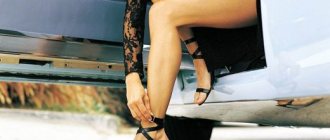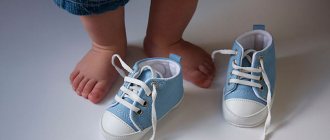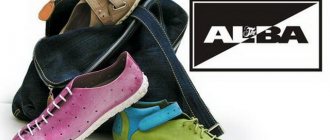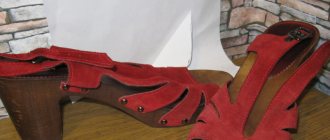…
Many women sincerely consider heels to be the greatest invention in the fashion world. Even representatives of the fair sex, who prefer comfort and a sporty style, cannot help but admit that high-heeled shoes are beautiful, sexy and favorably emphasize the figure and become the owner. However, some women avoid shoes with heels, citing the fact that moving in them is inconvenient and scary: you can fall and break something, the gait is quite awkward if you have no experience, your legs get tired quickly, and in general, try to catch up in such shoes bus departing from the stop or run to the fifth floor for papers forgotten in a hurry!
However, there are situations when you simply cannot do without heels. This could be a formal event, where the dress code requires you to wear an evening dress, or a romantic date, where you need to hit a fan in the heart. The same may not happen to women: shoes of unimaginable beauty accidentally seen in a store window can make a supporter of the sporty style turn away from her adored sneakers and awaken the desire to learn how to flutter above the ground in frivolous stilettos.
Surprisingly, learning to walk in heels is actually not difficult. You just need to practice a little and your exciting gait will captivate everyone.
Photo: depositphotos.com
Choosing shoes
Many believe that you should start training by walking in low heels, increasing its height with each subsequent pair of shoes. In fact, little depends on the height of the heels, and the requirements for shoes, boots or ankle boots should be as follows:
- As already mentioned, it is not the height of the heel that is important, but its shape, which determines stability. Beginners can try wedge or cowboy heels, but they are not found in dress shoes. For those who want to immediately conquer “great heights”, it is better to choose a column heel: it is wide, stable and does not weigh down the shoes, like its stacked counterpart. Aerobatics - the ability to walk on stiletto heels or cone-shaped heels. Beginners can afford these types of shoes, but the requirements for other shoe parameters should be stricter.
- The last of high-heeled shoes can only be perfectly comfortable. The slightest discomfort that you felt during fitting will inevitably turn into severe inconvenience in the future.
- Shoes with heels must be chosen strictly according to size; shoes with a number larger or smaller will not bring anything but negative emotions, and in some cases, injuries.
- If the shoes fit perfectly on your feet, you should definitely get up and walk around the store, even if this is not easy due to lack of experience. Walk, sit down and stand up, try to turn around or speed up your step - all this time the shoes should be one with you and not remind you of themselves by rubbing your feet, rolling or sliding.
- It is advisable that high-heeled shoes have a small webbing or straps around the ankle: such shoes will fit more securely and make the gait more stable. Stiletto heels are an absolute taboo, no matter how insanely beautiful they are.
- Forget about your desire to save money. Shoes, in principle, should be inexpensive and of high quality, and even more so the first heels. If you don’t want to spend too much on weekend shoes for your loved one, be prepared for a broken heel, dislocation, worn out heels and a spoiled mood.
If you are completely satisfied with the shoes, buy them with confidence. But keep in mind: if you walked effortlessly on a perfectly flat surface in a store, no one can guarantee that you will feel just as at ease on slippery tiles, chipped asphalt or paving stones. Therefore, while the warranty period for the purchase is valid, it is advisable to learn how to walk correctly in heels, and to do this, wear them more often and try them on different surfaces.
How to choose the right shoes so as not to experience foot pain?
It’s easy to identify problems with a girl’s legs and back by looking at her shoes. The shoes are put on the foot. The main task of the foot is to absorb the weight of a person when walking. Without shock absorption, the spine and leg joints suffer. Possible diseases due to incorrectly chosen shoes:
- Arthritis, arthrosis;
- Scoliosis;
- Varicose veins;
- Flat feet;
- Problems with internal organs.
For the safety of the health of the back and legs, women are recommended to wear shoes with heels no higher than 5 centimeters. Orthopedists do not recommend heels higher than 9 centimeters. Frequent wearing of heels leads to deformation of the ankle and foot. If a woman is not used to wearing heels, it is recommended to increase the height gradually.
Heel height
Women are familiar with foot pain caused by heels. After walking in stilettos, pain is felt in the heel tendons, feet and toes ache. Let's look at what to do to prevent your legs from hurting.
If pain and heaviness in your legs are constant, consult an orthopedist. There may have been serious changes in the tendons and joints due to the heels. It has been scientifically proven that women are susceptible to foot diseases four times more often than men.
When walking in heels even 5 centimeters high, irreversible deformations of the feet occur, causing serious harm to the body. Due to improper redistribution of weight, the spine suffers and intervertebral discs wear out.
Constantly wearing high-heeled shoes has a bad effect on internal organs. Doctors do not recommend that teenage girls wear heels. Frail organs are displaced, which will lead to big problems in the future.
- When purchasing a new pair of fashionable shoes, pay attention to the heel height. Do not purchase shoes with heels higher than 9 centimeters. Recommended heel height is 5 – 9 centimeters. They make the legs look slender and there is no strong pressure on the feet.
- When walking in heels for a long time, have a spare pair of shoes. It is important not to wear stiletto heels all the time if your job is sedentary. An unnatural position of the knee joints can lead to arthritis.
- Orthopedic insoles will serve as a shock absorber when walking. Shoe manufacturing companies offer a range of such insoles. They soften blows to the knee joints and spine.
- Don't buy shoes that are too narrow. Tight shoes impair blood circulation. Accordingly, fatigue in the legs will appear earlier and it will be more difficult to relieve it. A narrow nose shape will lead to deformed toes, which looks unsightly.
To ensure that high-heeled shoes bring joy and do not cause discomfort, choose your shoes carefully! You should sacrifice beauty and fashion for the sake of healthy legs and body.
Learning to walk in heels: training posture
A high heel implies a special appearance. To feel confident and irresistible in high heels or stilettos, you must:
- Straighten your shoulders;
- Keep your back perfectly straight;
- Straighten your neck and lift your chin;
- Relax your legs slightly at the knees;
- Look straight ahead.
To start, simply put on your heels and try standing with correct posture. Imagine yourself as a puppet being pulled by a string tied to the top of your head. At first it will seem tiring to you, but by training just three to four times a day for 5-7 minutes, you can feel confident and relaxed after a couple of days.
Rules for choosing shoes
In many ways, the comfort of wearing shoes depends on how correctly they were chosen. Be sure to try on a pair and do it in the evening. Everyone has edema, and the small reserve in the morning turns into unbearable pressure by night. If the fullness is insufficient, it will constantly press and squeeze until the pair breaks.
Patent leather heels are torture for wide feet. Tight shoes are generally not a choice for every day, which should not be forgotten, especially if you are prone to varicose veins and bunions. You can take a shift with you to important events - you will have time to be a star and give your legs a rest. Ballet flats or other, soft and comfortable, already worn-in shoes are suitable as a change.
The insole should preferably be soft, leather or suede. Synthetics are a bad option, they don’t breathe and rub. Also, artificial materials often give off an unpleasant odor. Check the shock absorption - bend the shoe slightly in the wide part, the bend should be moderate. Very soft and hard pads are the cause of pain in the legs towards the end of the day.
Don’t rush to make a purchase - put on your shoes and walk around the sales floor in them, sit, stand. There should be no pressing, rubbing or pressing on anything, and the foot should not slip either. When in doubt, a shoe doesn’t fit, look further. It will get used, but how. Ask for a guarantee - during this period the shoes can be returned. Shopping on the Internet without trying it on is not the best solution in this case.
We train our gait
We have already learned to stand in heels, now it’s time to move on, in every sense. If you can feel your body and develop correct posture, learning to walk in heels will not be so difficult. The main thing is to find a relatively spacious room with a flat floor for training and follow the following rules:
- You will be surprised, but a smooth and attractive gait does not come from the hip, but from the knee. If you move your entire leg forward, your gait will be unnatural and “broken.” You should step from the knee, bringing it forward and slightly upward.
- You should not place your feet strictly parallel, for fear that the toes of your shoes will catch on each other. You can mark a straight line on the floor and step strictly along it, taking a step a little wider.
- The golden rule is that the higher the heel, the wider the step. If you take small steps in high heels, it will look awkward. It's better to move slowly at first, but walk correctly.
- You need to step on your toes, and then smoothly roll onto your heel. Slamming your heels into the floor as hard as you can, for fear of falling, is not the best idea, and your gait will not be very attractive.
- Do not forget to maintain your posture - in this case, your gait will be very feminine.
When you put on high heels for the first time, try to walk slowly - speed does not play a role for now, it is important to feel your body and the correctness of your steps. If you feel tired, rest for a couple of hours and try walking again. When your gait becomes confident, try increasing your speed. And so on until you feel like a fish in water, moving at your usual pace.
If you succeed, reward yourself: turn on energetic music and walk along with a brisk, flying gait, imagining yourself as a top model at a luxurious fashion show. Remember this feeling and the music: when you put on your heels to go out, it will come in handy.
Other useful tips
High heels without sacrifice - this is real. Take the patch, wrap the third and fourth toes together, put on your shoes. Count not from the little finger, but from the big one - that is, the inner bone of the leg. Well-known top models use this method, so there is no point in not believing in its effectiveness.
Between these fingers there is a nerve, which causes severe pain in case of pressure. High heels shift the center of gravity - hence the discomfort. The patch will relieve pressure on the nerve, and please wear your favorite shoes all day long.
The method was invented by Marie Helvin, the legendary top model of the 70s, muse, and ex-wife of the trend photographer of that time, David Bailey. She knew how difficult it was to walk around in high heels and look like a true queen. Don't worry about appearance - the patch is completely unobtrusive. Choose flesh-colored adhesive plasters.
We're not talking about whether to wear heels or not - the emphasis is on how to do it correctly and why. For example, I don’t mind the time; I myself admire the reflection in the window, because a flying gait in thin heels is very beautiful.
So if the answer to the question whether to wear it or not is clearly “yes”, the following tips will be useful to you:
- Choose high-quality shoes - poor tailoring, hard material, and uncomfortable shape make wearing a pair almost impossible. So if you plan to be beautiful for a long time, choose a good pair. It won't be cheap, but you shouldn't skimp here.
- The thickness of the heel is also important - stiletto heels are not for every day, but a stable thick heel is just right. The foot gets used to it quickly, and the average thickness-to-height ratio also works well when worn. If desired, you can then switch to a thinner option.
- Wear a proven pair of shoes for the whole day - uncomfortable shoes can ruin a serious long-term event once or twice, so don’t experiment. Even sneakers with ballet flats are tinder. It is advisable to first break in any new shoes at home.
- Tie your fingers - no, this is not a joke. The third with four from the thumb in a tied form will help you forget about the pain in your feet. The most convenient way to do this is with a regular (non-bactericidal) plaster.
High heel: going out
So, the big day has arrived, and you are completely ready: the dress, makeup and hairstyle are flawless, high-heeled or stiletto shoes are perfect, and your gait is honed to perfection? Then a few more useful tips:
- Just in case, glue small pieces of sandpaper to the soles of your shoes: this will save you in a room with slippery floors.
- When going up the stairs, try to walk slightly sideways and place your feet on each step in turn: in this case, you will not trip, break your heel, and you will look graceful.
- Try not to keep your arms down along your body: if you're wearing heels, this will make you feel slouched even if you have perfect posture. It is best to occupy your hands with a flower or glass, or gracefully fold your palm into your palm at the level of the solar plexus.
- Walking in high heels for more than three hours without a break is not recommended. Try to find a secluded corner where you can take off your shoes and let your feet rest for at least 5-10 minutes.
- When you return home, be sure to do a foot massage and a foot bath with essential oil: this will help relieve muscle tension and normalize blood circulation.
And most importantly – smile! An easy walk and a charming smile are all you need to conquer! We hope our tips will help you learn to walk in heels easily and naturally.
Foot diseases from heels
With continuous wearing of stiletto heels, girls feel symptoms of the disease. Heaviness in the legs, swelling, numbness in the feet, pain in the veins. If the symptoms do not go away, do not wear heels - you are risking your health.
Arthritis of the joints occurs when overusing heels. It is impossible to cure arthritis or arthrosis. Characteristic symptoms of arthritis are joint pain, redness, and increased skin temperature in the joint area. Hormonal drugs are used to treat the disease.
Every girl has encountered corns - deformation of the ball of her toe. When walking in heels, a large angle is formed between the foot and the surface, which causes growths on the toes. Corns are easily removable, but cause discomfort. The pads of your fingers begin to burn; in this case, you will have to give up heels.
In addition to calluses and corns, heels cause deformation of the fingers. The big toe becomes bent, followed by the rest of the toes. The pressure is caused by improperly distributed body weight on the legs. The higher the heel, the more stress your toes experience.
Finger deformity
The cause of varicose veins is high-heeled shoes. Shoes often have a narrow nose, which impedes blood flow. The venous system suffers. Varicose veins appear on the legs. Varicose veins are easier to prevent than to treat. If the first symptoms appear, do relaxing exercises for your legs.
Foot massage
Massage your feet. This gives your legs a rest. By massaging the legs and feet, blood circulation improves. If you are prone to varicose veins, consult your doctor before getting a massage.
A classic massage is done after walking in heels. After taking off your shoes, applying a special cream or oil, massage movements are made. Use your fingers to move in a circular motion from heel to toe, in the opposite direction. The procedure takes 20 minutes.
Eastern medicine recommends massaging the kiketsu point, located on the outside of the foot, in the center between the heel and toe. The exercise is similar to lightly tapping a point. In the East, it is believed that in order to relieve leg fatigue, you need to hit the “kiketsu” point 100 times. But quickly tapping the “kiketsu” with your fingers is sufficient.
Another type of massage that came from the East is the use of walnuts. The feet contain nerve endings that directly interact with the body. To relieve fatigue, place two nuts on the floor and place your feet on them. Leg movements are made in both directions. The nut shell, due to its uneven surface, helps to activate the points located in the foot.
Foot massage
When walking for a long time, the spine gets tired, a back massage is advisable. The type of massage will be suggested by your doctor; incorrect independent actions can cause harm.









